22nd Sept – 3rd Oct: New Ballast Pump & Power system

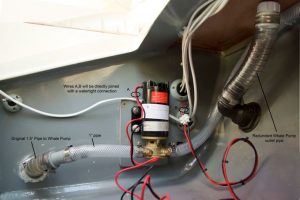 New Ballast Pump: At the Southampton Boat Show I had told Matt that the worst thing about Seatern was the Whale Gulper 220 ballast pump and after a discussion of alternatives and a bit of probing by me on various the boat show stands, he offered to buy me a Johnson Ballast Pump. These are sometimes referred to as “Wakeboard pumps” because boats used for wakeboarding have ballast tanks which are filled or emptied in order to shape the wake formed by the boat. The pumps used for this purpose are reversible so instead of using the forward facing self bailer to fill the tanks, the water can be pumped into them.
New Ballast Pump: At the Southampton Boat Show I had told Matt that the worst thing about Seatern was the Whale Gulper 220 ballast pump and after a discussion of alternatives and a bit of probing by me on various the boat show stands, he offered to buy me a Johnson Ballast Pump. These are sometimes referred to as “Wakeboard pumps” because boats used for wakeboarding have ballast tanks which are filled or emptied in order to shape the wake formed by the boat. The pumps used for this purpose are reversible so instead of using the forward facing self bailer to fill the tanks, the water can be pumped into them.
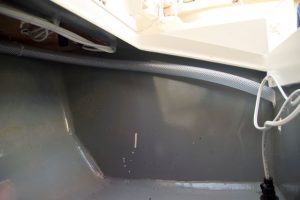 The pump arrived within a couple of days but it took me a few days to work out how and then to fit the pump in place of the Whale by connecting the 1″ pipes required into the existing 1.5″ pipework. The top photo shows the pump installed in the cockpit locker in place of the Whale. A reducer connects into the pipe going to the aft ballast tank. The Whale pump outlet in the side of the hull is blocked off using a plumbing fitting and the outlet/inlet pipe is routed along the top outboard edge of the locker under the seat panel.
The pump arrived within a couple of days but it took me a few days to work out how and then to fit the pump in place of the Whale by connecting the 1″ pipes required into the existing 1.5″ pipework. The top photo shows the pump installed in the cockpit locker in place of the Whale. A reducer connects into the pipe going to the aft ballast tank. The Whale pump outlet in the side of the hull is blocked off using a plumbing fitting and the outlet/inlet pipe is routed along the top outboard edge of the locker under the seat panel.
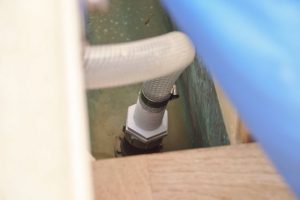 For the new Inlet/outlet I decided to use the through-hull fitting occupied by the NASA log paddle-wheel sensor. The latter has never worked properly because, sited in the starboard cockpit drain well beside the outboard well, I think it is in the wrong location on the hull. I got a 1″ through hull fitting and cut it down so I could attach it through the blanking cap provided by NASA for their fitting (see photo).
For the new Inlet/outlet I decided to use the through-hull fitting occupied by the NASA log paddle-wheel sensor. The latter has never worked properly because, sited in the starboard cockpit drain well beside the outboard well, I think it is in the wrong location on the hull. I got a 1″ through hull fitting and cut it down so I could attach it through the blanking cap provided by NASA for their fitting (see photo).
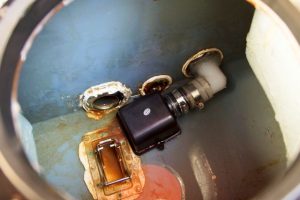 The ballast pump is not supposed to be run dry but I need it to empty the tanks as much as possible. I therefore used a pipe elbow and a Whale “Strum Box” to place the water inlet/outlet in the aft tank as low down and as near as possible to the lowest point. The elbow was just jammed into the existing 1.5″ outlet using a good amount of Fernox LS-X leak sealer!
The ballast pump is not supposed to be run dry but I need it to empty the tanks as much as possible. I therefore used a pipe elbow and a Whale “Strum Box” to place the water inlet/outlet in the aft tank as low down and as near as possible to the lowest point. The elbow was just jammed into the existing 1.5″ outlet using a good amount of Fernox LS-X leak sealer!
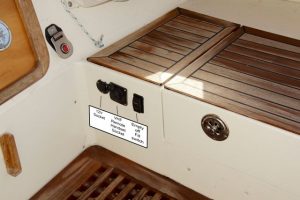 The direction of pumping is controlled by the polarity of the 12V supply. I therefore fitted a 12V DPDT switch in the cockpit. This needed a 20A rating so I chose a Blue Sea Systems Contura III 8286 from RJS Marine. Although the switch is ignition-protected, I situated it so the connections were in the electronics alcove in the cabin, rather than have it in the locker together with the petrol tank (the pump is also ignition-protected by the way!).
The direction of pumping is controlled by the polarity of the 12V supply. I therefore fitted a 12V DPDT switch in the cockpit. This needed a 20A rating so I chose a Blue Sea Systems Contura III 8286 from RJS Marine. Although the switch is ignition-protected, I situated it so the connections were in the electronics alcove in the cabin, rather than have it in the locker together with the petrol tank (the pump is also ignition-protected by the way!).
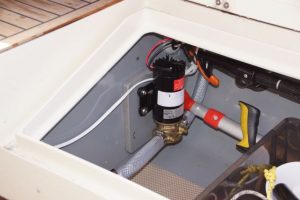 In tests the pump took about 6 minutes to fill the aft tank to hatch level plus another two minutes top up once the water had flowed through to the forward tank, consuming about 1.5 Ah. Emptying took about 11.5 minutes spread over 26 minutes (due to the time it takes for water to flow from the forward tank). Consumption was 1.8 Ah (compared to an estimated 5 Ah and 45 minutes pumping for the Whale). More details are can be accessed via the Equipment Summary web page.
In tests the pump took about 6 minutes to fill the aft tank to hatch level plus another two minutes top up once the water had flowed through to the forward tank, consuming about 1.5 Ah. Emptying took about 11.5 minutes spread over 26 minutes (due to the time it takes for water to flow from the forward tank). Consumption was 1.8 Ah (compared to an estimated 5 Ah and 45 minutes pumping for the Whale). More details are can be accessed via the Equipment Summary web page.
Power System During this period I also made changes to the electrical power system aimed at saving battery weight while allowing Seatern to be independent from shore power for periods of a few days or so. Since this is work in progress please contact me if you want more information.
